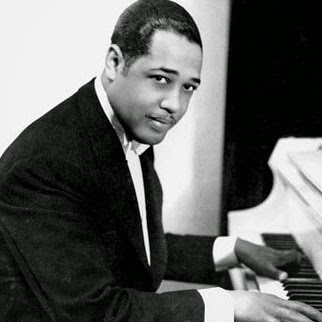 |
| Image source: http://www.ourvalleyvoice.com/2014/02/20/black-history-committee-plans-harlem-renaissance-celebration/ |
Thanks for joining me in the continuation of the Black History Month series on the Harlem Renaissance. This time we will look at the music. Links to examples from YouTube are at the bottom of the entry.
~~~
From the Wikipedia article on the Harlem Renaissance:
 |
| Duke Ellington |
During this period, the musical style of blacks was becoming more and more attractive to whites. White novelists, dramatists and composers started to exploit the musical tendencies and themes of African–Americans in their works. Composers used poems written by African-American poets in their songs, and would implement the rhythms, harmonies and melodies of African-American music—such as blues, spirituals, and jazz—into their concert pieces. Negroes began to merge with Whites into the classical world of musical composition. The first Negro male to gain wide recognition as a concert artist in both his region and internationally was Roland Hayes. He trained with Arthur Calhoun in Chattanooga, and at Fisk University in Nashville. Later, he studied with Arthur Hubbard in Boston and with George Henschel and Amanda Ira Aldridge in London, England. He began singing in public as a student, and toured with the Fisk Jubilee Singers in 1911.
During the Harlem Renaissance, Black America’s clothing scene took a dramatic turn from the prim and proper. African-Americans wore clothing that was far from somber. Women were dressed in wide hats garlanded with flowers, modest veils, silk stockings that were held up by garters, open-toed slippers, and the low-slung dress, possibly with a ribbon at the hip. Though the 1920s cloche, a close-fitting number usually made of felt or wool, was extremely popular for casual wear and was worn gaily pulled down over the eyes. Popular by the 1930s was the trendy beret hat with stand-up or egret feather. Men wore zoot suits which were wide-legged, high-waisted, pegged trousers, and a long coat with wide padded shoulders and lapels. They also wore wide-brimmed hats, hand-colored socks, white gloves, and velvet-collared Chesterfield coats. African Americans also expressed respect for their heritage through a style of leopard-skin coats indicating the great power of the infamous African animal.
During the Harlem Renaissance, Black America’s clothing scene took a dramatic turn from the prim and proper. African-Americans wore clothing that was far from somber. Women were dressed in wide hats garlanded with flowers, modest veils, silk stockings that were held up by garters, open-toed slippers, and the low-slung dress, possibly with a ribbon at the hip. Though the 1920s cloche, a close-fitting number usually made of felt or wool, was extremely popular for casual wear and was worn gaily pulled down over the eyes. Popular by the 1930s was the trendy beret hat with stand-up or egret feather. Men wore zoot suits which were wide-legged, high-waisted, pegged trousers, and a long coat with wide padded shoulders and lapels. They also wore wide-brimmed hats, hand-colored socks, white gloves, and velvet-collared Chesterfield coats. African Americans also expressed respect for their heritage through a style of leopard-skin coats indicating the great power of the infamous African animal.
~~~
.jpg) I chose the image of the Cotton Club for the first picture because no matter how one may feel in retrospect about the white gang affiliation of some of the better clubs in Harlem, one can't deny the iconic nature of this particular venue. I admit my introduction to this place was the 1984 movie which I haven't watched since back then so I barely remember it now.
I chose the image of the Cotton Club for the first picture because no matter how one may feel in retrospect about the white gang affiliation of some of the better clubs in Harlem, one can't deny the iconic nature of this particular venue. I admit my introduction to this place was the 1984 movie which I haven't watched since back then so I barely remember it now.I went through a jazz phase in the late 90s early 2000s after a decade of only listening to gospel. I owned all the classics. My favorite of course was Billie Holliday. There is something deeply moving about the music from this particular era. From the jump and shout big band to the haunting solo singers, the music captures so much of who we were at the time like a window into the past.
~~~
YOUTUBE:
Fats Waller -- https://www.youtube.com/watch?v=in1eK3x1PBI
Duke Ellington -- https://www.youtube.com/watch?v=qDQpZT3GhDg
Jelly Roll Morton -- https://www.youtube.com/watch?v=CIerJMCK5_E
Willie "The Lion" Smith -- https://www.youtube.com/watch?v=KDMOkgSdy3E (from the 1960s)
Roland Hayes -- https://www.youtube.com/watch?v=b8NGQGIogys
Billie Holliday -- https://www.youtube.com/watch?v=h4ZyuULy9zs
Cab Calloway -- https://www.youtube.com/watch?v=_8yGGtVKrD8 (from 1943)
~~~
IMAGE SOURCES:
Duke Ellington - http://wdim.aiwdepts.com/studentWork/IMD110/Jesse_Vargas/music.htm)
Roland Hayes - http://www.georgiaencyclopedia.org/articles/arts-culture/roland-hayes-1887-1977
Cab Calloway - http://pixgood.com/cab-calloway-zoot-suit.html
Billie Holliday - http://en.wikipedia.org/wiki/Billie_Holiday



No comments:
Post a Comment